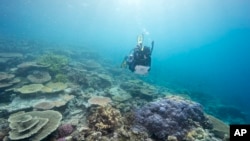Vast areas of Australia’s Great Barrier Reef, the world’s biggest coral system, have been affected by mass coral bleaching caused by a marine heatwave.
Surveys have shown major bleaching is occurring along the 2,300-kilometer ecosystem.
Bleaching on the Great Barrier Reef was detected weeks ago, but recent aerial surveillance carried out by the Great Barrier Reef Marine Park Authority and the Australian Institute of Marine Science revealed that 75 percent of 1,001 reefs inspected contain bleached corals. This means the organisms residing on them are struggling to survive.
A quarter of individual reefs surveyed recorded low to no levels of bleaching, while half had high or very high levels.
The authority that manages the reef confirmed “widespread bleaching across all three regions of the marine park” — its north, south and central sectors.
It said, “Sea surface temperatures remain 0.5-1.5 degrees above average for this time of year.”
Scientists say that corals bleach, or turn white, when they are stressed by changes in water temperature, light, or nutrients. In response, the coral expels the symbiotic algae living in their tissues, exposing their white skeleton.
Not all bleaching incidents are due to warm water, but experts say the mass bleaching reported on Australia’s Great Barrier Reef is caused by a marine heatwave.
“The coral will expel their micro algae and so when you see a bleached coral it is not dead, but it is starving," said Lissa Schindler, Great Barrier Reef campaign manager at the Australian Marine Conservation Society. She told VOA that bleaching makes corals fragile and weak.
"If they do recover, they will be more prone to disease and have a lower reproductive output. What happens, though, if temperatures are too hot for too long then the coral cannot survive and then that is when it dies, she said.
Schindler says that reefs around the world are becoming more vulnerable to bleaching due to the impact of climate change.
“We do not know how long our oceans can continue to absorb the amount of heat that they are, and I think these mass bleaching events that are occurring around the world are showing that this heat absorption is having a real impact on coral reefs and will continue to do so," she said. "So, with climate change there will be more severe and more frequent mass bleaching events to come to the point where coral reefs will not be able to recover in between these events.”
The Great Barrier Reef runs 2,300 kilometers down Australia’s northeastern coast and covers an area about the size of Japan.
Conservationists say it faces a range of threats, including warmer ocean temperatures, overfishing, pollution and coral-eating crown of thorns starfish.
The Australian government has a target to cut national emissions by 43 percent by 2030 and reach net zero by 2050.








